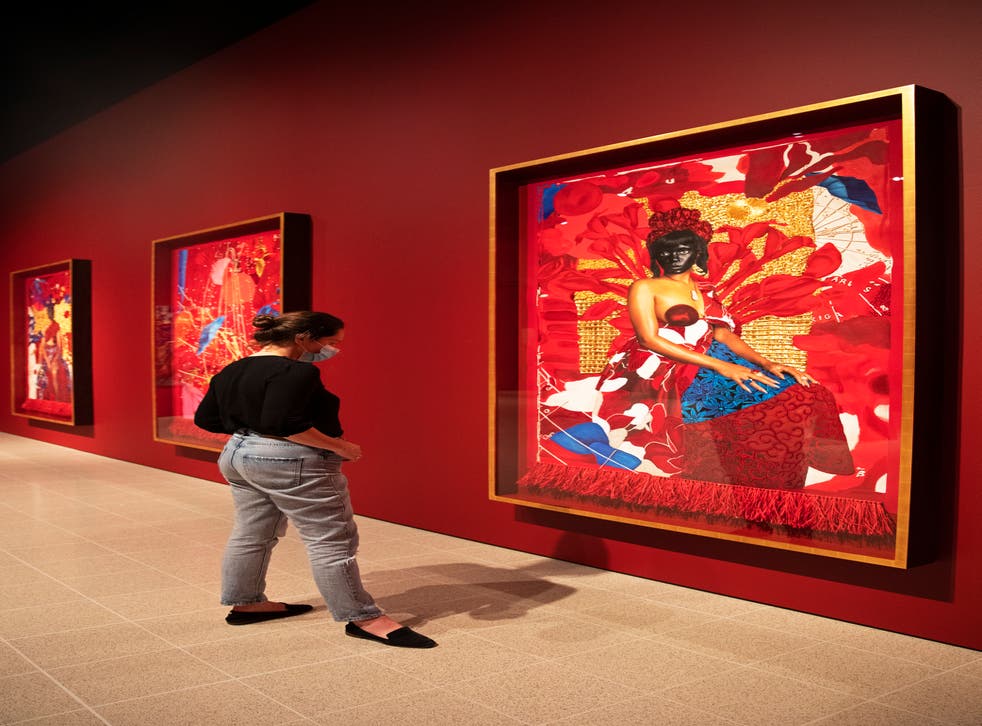The Hayward Gallery’s eagerly awaited exhibition is a fascinating look at an emerging sensibility – even if ‘the fantastic’ is an occasionally elusive concept.
Maybe it’s a reaction to the toughness of the times, but “the fantastic” is suddenly everywhere in art. From this year’s Venice Biennale, with its surfeit of updated surrealism and sci-fi-influenced cyborg imagery, to the just-finished London art school degree shows, there’s evidence of an emerging generational sensibility. It’s one that’s informed as much by gaming, super-hero franchise movies and manga as it is by post-modern critical theory.
This eagerly awaited exhibition feels bang on the money – and the moment – in adding the dimension of Blackness. Curated by critic and former ICA director Ekow Eshun, it brings together 11 artists from the African diaspora who “grapple with the racial inequities of contemporary society” through fantasy, myth and fable, informed by “the legacies of Afrofuturism”. The latter element feels key. Once niche, now almost mainstream, this retro-futurist aesthetic is evident in everything from the music of Sun Ra, George Clinton and Beyonce to the Black Panther and Watchmen movies. Afrofuturism puts Black people in the spaceship’s driving seat in a meta-future where it’s always somehow the 1970s.
The show’s catalogue provides a wonderful compendium of Afrofuturist imagery that could make it the definitive guide to the style: from album covers to fashion photography, Afro-modernist architecture and film stills. There’s even quite a bit of actual art-art, from well-known figures such as Kerry James Marshall, Yinka Shonibare and Kara Walker.
The exhibition itself, meanwhile, is a very different, and considerably more austere affair.
The opening works, though, lock us straight into the Afrofuturist vibe. We see a collection of Soundsuits (2014-2022) by American sculptor Nick Cave (no relation to the post-punk singer-songwriter). These wearable sculptures, conceived 30 years ago in response to the beating of Rodney King, have been updated here to commemorate the killing of George Floyd. Although they don’t actually emit sound, they certainly create a visual racket in their amalgam of African masquerade aesthetics and space-age bling. A button-encrusted suit from 2014 looks like a cross between a Pearly King’s outfit and a human-sized hairdryer with a whirl of Day-Glo coloured nylon fur for a face. Cave’s specially commissioned Chain Reaction has a powerful, sombre ambiguity, with hundreds of casts of the artist’s arm joined, chain-like. The work is suspended from the ceiling as part of a room-dividing curtain that hints at desperation and hope, connectedness and imprisonment.
New York-based Kenyan artist Wangechi Mutu’s densely textured and surreal collages are some of the better-known works here; their inclusion feels a touch obvious. More surprising and interesting are Mutu’s sculptures, which nod towards traditional African forms with their earthy textures, though their free-flowing, expressive lines are unlike anything seen in actual traditional sculpture. Yet the Afrofuturistic sense that the classical African past can be freely, even ironically interpreted is muted by the exhibition’s stark and sterile presentation. If the catalogue suggests we’re in for an ambience midway between a record shop, a nightclub and a fashion show, the show itself seems desperate to prove it’s a deadly serious contemporary art exhibition with lots of space between works – sometimes far too much – and dry as dust explanatory wall panels.
New York-based British-Liberian artist Lina Iris Viktor’s densely textured, dramatised self-portraits are some of the show’s most immediately compelling works. Yet their complex interplay between historical reference and fashion-glamour immediacy seem to cry out for a form of display more imaginative than being just plonked on a wall. British artist Hew Locke’s installation is more coherent and involving. A series of gem-laden, gun-toting self-portraits creates a sinister backdrop for minutely detailed sculpted figures of quasi-Rastafarian “ambassadors” astride jewel-encrusted horses. They perfectly embody the new digitally empowered meta-art in a satiric take on colonial statuary.
Of the two deconstructions of binary gender norms, American artist Rashaad Newsome’s gleefully bonkers amalgams of old master painting, African sculpture and gangster jewellery are vastly more entertaining than French artist Tabita Rezaire’s preachy projections onto a silver pyramid. Yet Newsome’s combustibly funky video of a digitally created dancer voguing through an urban apocalypse – which set out to both to “reimagine the body (and) detonate the structures around it” – feels under-served by the plainness of the presentation. Perhaps, though, the absence of the wildly patterned wallpaper from the original American installation is down to economic factors.
And finally the show left me questioning the value of “the fantastic” as an ideal in itself. One of the best works here, Cauleen Smith’s Epistrophy (2018), centres on a group of the artist’s treasured personal possessions – more African sculptures, dolls, shells, a stuffed raven – projected onto the surrounding walls via a live feed. It’s played over videos of her travels, so we see her plastic dolls framed in real time against smouldering volcanoes, rippling oceans and rolling savannas. It’s a brilliant and genuinely immersive visualisation of thought processes that allow us to be simultaneously in the realms of the domestic and the epic. But how much does it have to do with “the fantastic”? Indeed, is “the fantastic”, with its slight implication of the frivolous, the best way of approaching Chain Reaction, Nick Cave’s dangling frieze of grasping arms, with its stark and moving evocation of racial alienation in contemporary America?
My takeaway from this fascinating exhibition: the harder you look at the fantastic, the more it seems to evaporate, leaving a view of the hard and tangible realities beneath – we’re back to earth once more.

Lina Iris Viktor’s densely textured, dramatised self-portraits are some of the show’s most immediately compelling works
Some great works are thinly distributed through the upper galleries. Ellen Gallagher’s Ecstatic Draft of Fishes paintings (2019-2021) imagine an undersea realm populated by the descendants of pregnant women thrown overboard from slave ships. It’s a visionary and brilliantly original merging of mesmeric, Klimt-like abstract pattern and stylised African form. The implicit horror of the subject you have to work at yourself.
Chris Ofili’s powerful sculpture Annunciation (2006) depicts the visitation of the Angel Gabriel to Mary as a vigorously sensual coupling, with Mary rendered in bright, polished bronze, Gabriel in a rougher dark-hued texture. It’s a challenging work. I was less convinced by Ofili’s three paintings inspired by the myth of Odysseus and Calypso, and the fact there are only three of them in the very large space takes the notion of the minimal “contemporary” hang to an absurd extreme. I appreciate we have to be grateful for whatever exhibitions we can get in these straitened times (which are only likely to get worse), but with a theme as rich as this you want sumptuous overload, not pared-back refinement


